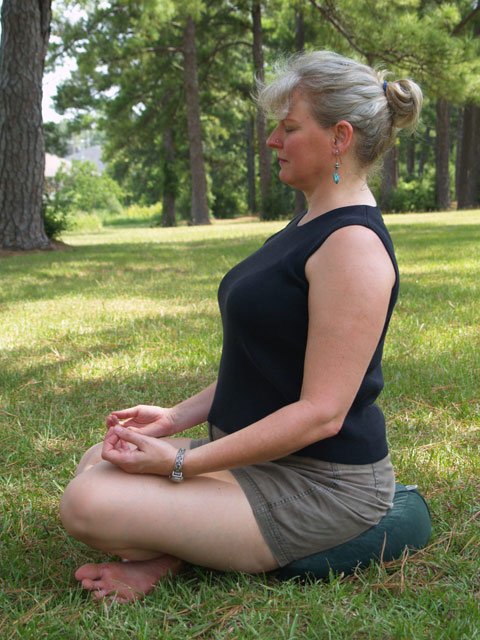Debi Lewis of JoyFlow Yoga demonstrates good meditation posture using a zafu cushion. Photo by Ronni Mott
It's Saturday morning. I take a comfortable seat on a floor cushion and close my eyes. For a few moments, I focus on my breath moving steadily in and out. It takes no effort, since I'm breathing anyway.
"This is a waste of time" flits through my mind. "My foot is falling asleep."
I bring my attention back to my breath. I repeat a mantra silently: Om Namah Shivaya GuraveI offer myself to the Light, the auspicious one, the true teacher within and without. Slowly, I expand my awareness to include other sensations: the air on my skin, sounds from the garden, a cat playing with a toy, my own heart beating.
Thirty minutes later, I'm calm, grounded and ready to face whatever might come my way.
Luke and Charlotte Lundemo are long-time meditation practitioners, he since the '70s, she since '82. In addition to teaching meditation at Millsaps College, they own the Computer Co-Op in the Rainbow Plaza in Fondren.
What is the primary goal of meditation?
Luke Lundemo: Many people take on meditation to reduce stress. There are a lot of physical issues that meditation is beneficial for. As a spiritual path, it's really useful for self-inquiry to learn your own answers to the big questions: Who am I? What is the purpose in life? Meditation gives you a quiet place to find a deeper answer to those questions.
Charlotte Lundemo: Some people go for more esoteric reasons: your connection to everything else in the universe including the universe; being part of the whole.
What kinds of health problems can be helped through meditation?
LL: I used to have asthma real bad. During the fall, I would get attacks; my throat would close up and I'd have trouble breathing. I found that by meditating for about 15 minutes and really paying attention and getting present, the symptoms would go away, and it lasted usually a couple of hours.
CL: So far as people that have taken our classes, a lot of them come for general reasons: blood pressure, stress, learning to cope with everyday life better without reacting so strongly one way or another, coping better.
LL: Meditation can do tremendous things about pain. Our normal reaction to pain is to run away from it, and it just makes it worse. (University of Massachusetts Medical School Professor of Medicine) Jon Kabat-Zinn teaches meditation where people are invited to take a close look at pain, and in many cases the pain starts breaking up into its elementspressure, tightness, heatand becomes a different experience. It's not this big, heavy, mind-numbing thing you can't deal with.
Are there different types of meditation?
LL: The big division is the concentration practices and the more loving, being-aware-of-everything-that's-happening practices. Some people go just after developing concentration: they'll find a meditation objecta candle, the breath, a mandalaand they go deeply into that object to the exclusion of everything.
CL: Ram Dass practices Karma Yoga, which is service (meditation). You evolve through service. He said that you have to help people while you're working on your own evolution.
LL: Many artists have their own techniques of getting into the state where they're most creative, and it usually involves some type of meditation. Same with athletes getting into "the zone." They block out everything that's irrelevant to the task at hand.
Is meditation religious?
LL: No. When people tried to pin the Buddha down by asking: "Are you an angel? Are you a prophet?" he responded simply, "I'm awake."
What's the best way to get started?
LL: There are a lot of good books and booklets. We have a lending library here (at the Computer Co-op). The big thing is finding time. For many people early in the morning before things get going (is best). Most people can have a lot of success if they just sit in a posture that's comfortable, with their spine straight, but not tight, in a chair or on a cushion.
CL: If you lie down, you're liable to fall asleep.
LL: Watching the breath is better than looking at a candle for most people. Most people won't settle down until about 15 minutes into it, but even five minutesyou get a taste of it. Five to 15 minutes is a good time to start with.
CL: You don't have to stop your mind. Just watch the thoughts going by, not getting attached to them. You don't react until you get attached.
Where2Shop
Aqua the Day Spa
Banner Hall, 4465 I-55 N., 601-362-9550
Joyflow Yoga
2002 Pinehaven Dr., Flowood
601-613-4317
Joyflowyoga.com
Lemuria Books
Banner Hall, 4465 I-55 North, 601-366-7619
lemuriabooks.com



Comments
Use the comment form below to begin a discussion about this content.
comments powered by Disqus